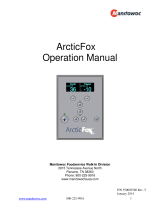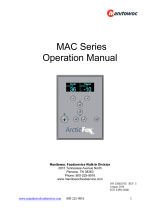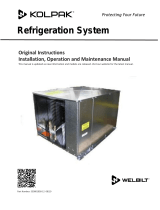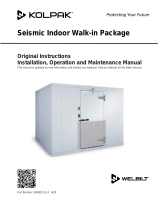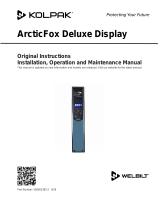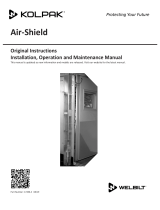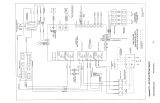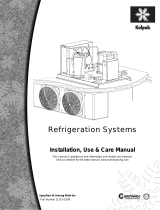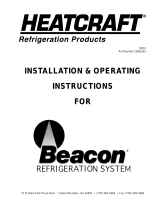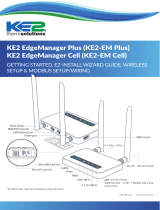Page is loading ...

Protecting Your Future
ArcticFox WiFi Controller
With Tru-Dmnd™ Defrost
Original Instructions
Installation, Operation and Maintenance Manual
This manual is updated as new information and models are released. Visit our website for the latest manual.
Part Number: 550005898-3 9/19

2
Read this manual thoroughly before operating, installing or
performing maintenance on the equipment. Failure to follow
instructions in this manual can cause property damage, injury or
death.
Ensure that all field wiring conforms to the equipment
requirements and all applicable local and national codes.
Installation and maintenance/servicing are to be performed only
by trained and qualified personnel familiar with commercial
refrigeration systems.
Indicates a situation that, if not avoided, could damage the
refrigeration system or result in minor injury.
Safety Notices
NOTE: Indicates useful, extra information about the
procedure you are performing.
DANGER
Indicates a hazardous situation that, if not avoided, will
result in death or serious injury. This applies to the most
extreme situations.
Notice
Indicates information considered important, but not hazard-
related (e.g. messages relating to property damage).
Disconnect all power sources before servicing the refrigeration
equipment.
Use appropriate eye protection during installation and servicing.
Sheet metal and coil surfaces have sharp edges. Use appropriate
protective gloves to prevent injury.
Indicates a hazardous situation that, if not avoided, could result
in death or serious injury.

3
Table of Contents
Section 1
General Information
Receiving Inspection ........................................................ .......................................................... 4
Warranty Information ................................................................................................................. 4
Section 2
Installation
Condensing Units ........................................................................................................................ 5
Evaporator Units ......................................................................................................................... 6
Section 3
Wiring
Wiring ......................................................................................................................................... 8
Section 4
Piping
Piping .......................................................................................................................................... 9
Cleanliness .......................................................................................................................... 9
Pipe Supports ...................................................................................................................... 9
Oil Traps ............................................................................................................................ 10
Drain Lines ........................................................................................................................ 10
Pre-Charged Lines ............................................................................................................. 11
Leak Testing .............................................................................................................................. 12
PR Models ......................................................................................................................... 12
PC Models ......................................................................................................................... 13
PCL Models ....................................................................................................................... 13
System Evacuation .................................................................................................................... 13
PR Models ......................................................................................................................... 13
PC Models ......................................................................................................................... 13
PCL Models ....................................................................................................................... 14
Refrigerant Charging ................................................................................................................. 14
Section 5
Operational Start-Up
Pre-Start Checks ........................................................................................................................ 15
Navigation Using The Basic Display ........................................................................................... 15
Introduction TO ArcticFox Smart Access .................................................................................... 16
Setting Up E-Mail / Text Alerts .................................................................................................. 22
Section 6
Maintenance
Preventive Maintenance Tasks .................................................................................................. 24
P.O.E. Lubricants ....................................................................................................................... 24
Section 7
Troubleshooting
Evaporator ................................................................................................................................ 25
Condensing Unit ........................................................................................................................ 26
System Start-Up Checklist ........................................................................................................................... 28

4
Section 1
General Information
Receiving Inspection
• Check the shipment carefully and compare to the bill of lading.
• Account for all items listed and inspect each container for damage.
• Carefully inspect for any concealed damage.
• Report any shortages or damages to the carrier, note on the bill of lading, and file a freight claim.
• Damaged material cannot be returned to the manufacturer without prior approval.
• A Return Material Authorization (RMA) must be obtained. Contact a sales representative at 800-826- 7036.
Warranty Information
For information regarding warranty guidelines, claim form, product registration, warranty verification, or
locating a service provider please visit our website at www.kolpak.com
or call 800-225-9916.

5
Section 2
Installation
Condensing Units
• Check the selected installation location to ensure that racks, braces, flooring, foundations, etc. are adequate to
support the condensing unit weight.
• The installation location is clean, dry, and level.
• Locate away from corrosive and noise sensitive atmospheres.
• Use the condensing unit skid and base when moving the unit. Do not remove unit from skid until the unit is moved to
the mounting location.
• Mount the condensing unit base to pads or structural rails using properly sized bolts through the unit base. Center of
condensing unit needs to be properly supported.
• Locate where there is a sufficient and unrestricted supply of clean ambient air.
• Locate where this is adequate space for the removal of the heated discharged air from the condensing unit area.
• Do not position multiple units so that discharge air from one unit is blowing into the condenser inlet air of the other
unit.
• All sides of the unit should be positioned a minimum distance equal to the total width of the condensing unit away
from any other unit, wall, or obstruction.
• Check the selected installation location to ensure that racks, braces, flooring, foundations, etc. are adequate to
support the condensing unit weight.
• The installation location is clean, dry, and level.
• Locate away from corrosive and noise sensitive atmospheres.
• Use the condensing unit skid and base when moving the unit. Do not remove unit from skid until the unit is moved to
the mounting location.
• Mount the condensing unit base to pads or structural rails using properly sized bolts through the unit base. Center of
condensing unit needs to be properly supported.

6
Example of Multiple Units with Horizontal Airflow
Evaporator Units
• Do not place the evaporator above or close to door openings. This will help prevent potential icing problems.
• Allow a minimum clearance equal to or greater than the coil height on all sides of the coil for proper air flow and
service access.
• Use the evaporator coil for a template to locate and drill the mounting holes (1/2” diameter).
• Place a 1” and a 1-5/8” washer on each nylon bolt and insert through the drilled mounting holes in the ceiling from
the exterior of the walk-in ceiling panel.
NOTE: Nylon bolts are supplied to prevent thermal transfer between the exterior of the walk-in and the interior of the walk-
in. Do not use metal bolts.
• Lift the evaporator coil until the nylon bolts extend through the mounting brackets.
• Install washers and secure with nuts. Tighten until the coil is firm against the ceiling. The evaporator coil must be
level.
• Additional information is available in the installation manual supplied with the evaporator.
CAUTION
Failure to observe clearance and air flow requirements will result in poor system performance and premature
equipment failure!
CAUTION
Failure to observe clearance and air flow requirements will result in poor system performance and premature equipment
failure!
BUILDING WALL
(VIEWED FROM ABOVE)
AIR
FLOW
AIR
FLOW
MINIMUM
DISTANCE
24”
INTAKE AIR
MINIMUM DISTANCE 24”
24”
INTAKE AIR
MINIMUM DISTANCE 24”
24”

7
Evaporator Coil Mounting Diagram

8
Section 3
Wiring
Wiring
• All electrical connections and routing must comply with local and national codes.
• Do not modify the factory installed wiring without written factory approval.
• The field wiring must enter through the knockouts provided.
• Refer to the nameplate on the condensing or evaporator coil to determine the proper electrical power supply.
• Wire type should be of copper conductor only and properly sized to handle the electrical load.
• The unit and coil must be properly grounded.
• Condensing unit wiring diagrams are and attached inside the electrical box cover.
• Evaporator coil wiring diagrams are and inside the evaporator cover.
NOTE: CAT-5 cables, which are included, need to be routed from the evaporators to the network router
for access to the internet. Please contact the end user for proper connection point.
WARNING
All wiring must comply with local and national codes. Wiring must be performed only by a refrigeration
technician or certified electrician. Failure to follow these guidelines may result in injury!
CAUTION
Check all wiring connections, including factory terminals, before operation. Connections can become loose
during shipment and installation.

9
Section 4
Piping
Piping
• All refrigeration piping and components are to be installed in accordance with applicable local and national codes and
in conformance with industry refrigeration guidelines to ensure proper operation of the refrigeration system.
• Only refrigeration grade copper tubing should be used.
• Long radius elbows should be used. Short radius elbows have points of excessive stress concentration and are subject
to breaking at these points, do not use short radius elbows.
• Suction lines must be insulated with a minimum ¾” thick insulation tubing to reduce heat pick-up.
Cleanliness
• Condensing units and evaporator coils are cleaned and dehydrated at the factory.
• The condensing unit must remain closed and pressurized until the piping is complete and final connections are ready
to be made.
CAUTION
The maximum air exposure for dehydrated condensing units is 15 minutes. Systems exposed longer than 15
minutes must have the compressor oil and drier filter replaced. Leaving a system exposed to the atmosphere
for more than 15 minutes can result in premature system failure.
• Do not remove base mount valve covers until work is ready to be performed.
• Ensure that all refrigeration tubing is clean and dry prior to installation.
• Use only tubing cutters when trimming tubing to the proper length. Do not use saws to cut tubing.
CAUTION
The use of saws to cut tubing can contaminate the system with copper chips causing premature system failure.
• Brazing joints require a dry inert gas, typically nitrogen, be passed through the lines at a low pressure to prevent
scaling and oxidation.
• Use only silver solder brazing alloys. Minimize the amount of flux to prevent internal contamination. Flux only the
male portion of the joint.
• Thoroughly clean fluxed joints after brazing.
CAUTION
Dry inert gas must be passed through the system while brazing to prevent scaling and oxidation. Scaling and
oxides can clog refrigeration components resulting in system failure.
Pipe Supports
• All tubing should be supported in a least two locations (near the end of each tubing run).
• Long runs will require additional support.
• As a guide, support 3/8” to 7/8” pipe every five feet, 1-1/8” to 1-3/8” every seven feet, and 1-5/8” to 2-1/8” every ten
feet.
• Do not leave a corner unsupported when changing directions.
• Place supports within 2 feet of each direction change.
• Piping that is attached to a vibrating object (such as a compressor or compressor base) must be supported in a
manner that will not restrict the movement of the vibrating object.
• Rigid mounting will fatigue the tubing causing refrigerant leaks.

10
Oil Traps
• To ensure proper oil return to the compressor, a P-type oil trap should be installed at the base of each suction riser of
four feet or more.
• The suction trap must be the same size as the suction line.
• Additional traps are necessary for long vertical risers. Add a trap for each length of pipe (approximately 20 feet) to
insure proper oil return.
• Suction lines must slope ¼” per 10 feet toward the compressor.
• Install a suction line trap at the evaporator outlet if the suction line rises to a point higher than the connection on the
evaporator.
CAUTION
Failure to properly install oil traps can prevent sufficient oil return to the compressor resulting in premature compressor
failure.
Drain Lines
• Evaporator coil drain lines should be pitched a minimum of 1/2” per foot to allow proper drainage and exit the walk-in
as quickly as possible.
• Insulate and seal the drain line where it passes through the wall.
• Copper drain line is required.
• Freezer compartment drain lines must have heat tape wrapped around the copper drain line and must have ¾” thick
insulation tubing.
• Do not locate drain line P-traps within the freezer space.
• Do not reduce the drain line size.
• Locate a drain line P-trap outside of the cooler space.
• Any outdoor P-traps exposed to low ambient temperatures should be wrapped with a drain line heater (provide 20
watts of heat per foot of drain line at 0°F, 30 watts per foot at -20°F.
• Freezer/cooler combo boxes can have one common drain line. However, there must be a P-trap located between the
freezer evaporator and the cooler evaporator located inside the cooler compartment.
• The cooler compartment P-trap should be located between the cooler evaporator and the external drain location.

11
Pre-Charged lines and Quick Connects
• Route the suction and liquid line sets between the condensing unit and evaporator coil following the piping guidelines
identified in this manual.
• Remove the dust caps from the quick connect fittings and verify that the o-rings are intact.
• Wipe the coupling seals and threaded surfaces with a clean cloth to prevent contamination.
• Lubricate the threads and o-rings with Polyol Ester oil.
• Thread the coupling halves together by hand to ensure proper thread mating.
• Tighten with a wrench until the coupling bodies “bottom” or until there is definite resistance.
• Tighten an additional ¼ turn to ensure proper brass-to-brass seating.
• Once the system is opened and pressurized, check each fitting for refrigerant leaks. If a leak is detected, tighten until
the leak stops.
WARNING
Do not loosen and disconnect the quick connect fittings before reclaiming the refrigerant and depressurizing the
system. Disconnecting a pressurized system can result in injury!

12
CAUTION
Quick connects are for one time use only. Once disconnected, the coupling cannot be re-used. Refrigerant leaks
will occur if the couplings are re-used resulting in poor system performance.
• Excess line set length should never be allowed to coil in the vertical position. Excess line length should be laid flat on
its side.
Leak Testing
• After all connections are complete the refrigeration system must be tested for leaks.
• Failure to perform a leak test can result in unsatisfactory system performance, additional servicing and service costs,
and possible system failure.
• Leak test should be performed using an electronic leak detector.
• All joints and components, both factory and field installed, should be thoroughly inspected for leaks.
• The system installation must be leak free!
Leak Testing “PR” model systems
• Open both the liquid and suction service valves.
• Ensure the solenoid valve is energized and open.
• Add 50 psi refrigerant, then pressurize with dry nitrogen to the low side test pressure identified on the unit rating
label.
• Allow thirty minutes for refrigerant to reach all parts of the system.
• Check all joints and components with an electronic leak detector.

13
Leak Testing “PC” model systems
• Leave the service valves closed, the condensing unit is charged with refrigerant.
• Ensure the solenoid valve is energized and open.
• Add 50 psi refrigerant, then pressurize with dry nitrogen to the low side test pressure identified on the unit rating
label.
• Allow thirty minutes for refrigerant to reach all parts of the system.
• Check all joints and components with an electronic leak detector.
Leak Testing “PCL” model systems
• Open both the liquid and suction service valves.
• Ensure the solenoid valve is energized and open.
• Allow thirty minutes for refrigerant to reach all parts of the system.
• Check all joints and components with an electronic leak detector.
• If a leak is detected, relieve the pressure and/or reclaim the refrigerant and repair the leak.
• If additional brazing is required, pass a dry inert gas (nitrogen) through the system to prevent contamination.
• Reference page 12 of this manual for leaks located at quick connects couplings.
• Retest the system as outlined above until no leaks are detected.
CAUTION
If a braze joint is detected leaking, dry inert gas must be passed through the system while repairing the joint to prevent
scaling and oxidation. Scaling and oxides can clog refrigeration components resulting in system failure.
CAUTION
Always use the system specified refrigerant when pressuring to perform a leak test.
System Evacuation
• Evacuation of the refrigeration system is necessary to remove all air and moisture from the system.
• A reliable rotary vacuum pump with an accurate deep vacuum gauge is recommended.
• Do not use the system compressor as a vacuum pump and do not operate the compressor while the system is under
vacuum.
Evacuation of “PR” model systems
• Open both the liquid and suction service valves.
• Ensure the solenoid valve is energized and open.
• Connect vacuum pump to the liquid and suction service valves located on the condensing unit.
• Evacuate the system to 250 microns and maintain for a minimum of 4 hours.
• Perform a vacuum decay test for a minimum of ten minutes to ensure the system is leak free and dry.
Evacuation of “PC” model systems
• Leave the service valves closed, the condensing unit has been evacuated and is charged with refrigerant.
• Ensure the solenoid valve is energized and open.
• Connect vacuum pump to the liquid and suction service valves. located on the condensing unit.
• Evacuate the system to 250 microns and maintain for a minimum of 4 hours.
• Perform a vacuum decay test for a minimum of ten minutes to ensure the system is leak free and dry.

14
Evacuation of “PCL” model systems
• “PCL” systems do not require evacuation.
CAUTION
Do not use the system compressor to evacuate the system. Do not start the compressor while the system is under
vacuum. This may damage to the compressor and cause premature system failure.
Refrigerant Charging
• The refrigerant charge should be added to the system through the liquid line service valve located on the condensing
unit.
• Do not charge liquid refrigerant into the suction service valve!
• The initial charge should be determined by weight and sight glass indication.
• Start the system. If the condensing temperature is 105° F or greater, charge the system until the sight glass clears.
• If the condensing unit temperature is below 105° F, reduce the condenser face surface area to raise the discharge
pressures above 105° F and to charge to a clear sight glass.
• Return to a full condenser face area when charging is complete.
NOTE: PC & PCL refrigerant charge amounts are based on average ambient operating temperatures across the United
States. Any refrigerant amount added or removed based on ambient operating temperatures is considered part of normal
maintenance and is not covered under warranty.
CAUTION
Do not charge liquid refrigerant into the suction service valve located on the condensing unit. Do not overcharge the
system. These conditions can permit liquid refrigerant to enter the compressor and cause damage to internal
components resulting in premature system failure.

15
Section 5
Operational Start-Up
Pre-Start Checks
• The first 2 – 4 hours of operation after initial start-up is a critical time.
• Do not just start the system and leave.
• Pressure values, compressor and evaporator superheat, and inspecting for excessive vibrations and loose connections
are some of checks that must be performed prior to leaving the system.
• Verify that all service valves are fully open.
• Ensure that all refrigerant and electrical connections are tight.
• Verify that the wiring and piping is properly routed and secured.
• The compressor mounting bolts are properly adjusted (see compressor mounts on page 18).
• All fan motors and mounting brackets are tight.
• The condensing unit base and evaporator coil are properly secured.
Navigation Using The Basic Display
• The ArcticFox WiFi OEM board has multiple methods of user input.
• Evaporators ship with the Basic Display installed on the right evaporator end panel.
• This display uses KE2 Therm’s familiar menu structure to allow service technicians to change the major setpoints.
• The setpoints may also be accessed using the controller’s webpages.
• To view a Service Video on how to setup the ArcticFox WiFi controller for remote access, scan the QR code below.

16
Introduction to ArcticFox Smart Access
• ArcticFox Smart Access provides quick and easy, real time access to your refrigeration systems, 24/7. The ArcticFox
WiFi OEM has always been internet accessible, but now it’s easier than ever to monitor and adjust your ArcticFox WiFi
OEM remotely.
• While the ArcticFox WiFi OEM’s free connectivity is still available, Kolpak recognizes that some customers prefer the
simplicity and convenience of ArcticFox Smart Access to provide the benefits of the controller’s communication
capability.
• All the ArcticFox WiFi OEM needs is a physical connection to the network router with a CAT-5 cable. Once enabled,
ArcticFox Smart Access quickly connects to your personal web portal, hosted by KE2 Therm, and provides a
“customized” dashboard of all the controllers you setup with ArcticFox Smart Access.
• The Arctic Fox Wifi controller is designed to provide energy saving, trouble free operation for your walk-in coolers and
walk-in freezers. In addition, you can also set up the controller for remote monitoring and alarming with a few easy
steps. Start by connecting a CAT-5 cable to the laptop and the ethernet port on the evaporator.
• Once connected to the Arctic Fox Wifi controller, the next step is to get the IP address of the controller from the basic
display. The IP address is made up of IP Octet 1, IP Octet 2, IP Octet 3, and IP Octet 4 (example: 10.10.52.19).
• Using the UP or DOWN arrow, scroll until you see IP Octet 1.

17
• Press ENTER to get the three digit address.
• Press BACK to get back to the IP Octet 1. Using the arrows, scroll until you see IP Octet 2. Repeat this process until
you have all four Octets that make up the address of this control.
• Now, type the IP address of controller into the address bar in a web browser on your device.
• The controller interface will display a home page…Click on ‘Settings’ tab.

18
• Click ‘Login’ to login to controller.
• The default username is afadmin. The default password is also afadmin, all lower case. You are now able to make
changes to the controller.

19
• You should now set the ArcticFox Smart Access Site and Password - Numbers and letters only, these can be upper and
lower case.
• Make sure to make the Site and Password something that you can remember as you will use this Site and Password to
remotely connect to the controller. Multiple controllers can have the same Site and Password.
• You should also set the controller Location to something that tells you where the specific controller is, for example
“Beer Cooler Store 689”, as you may have multiple locations on one Smart Access Site and Password.

20
• Once you have entered the information, Click ‘Save’… don’t be alarmed as you may briefly lose connectivity.
• After 30-60 seconds, click ‘Home Page’
/
